French fries
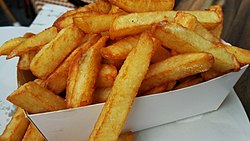 | |
| Alternative names | Chips, Finger chips, fries, frites, hot chips, steak fries, potato wedges, wedges |
|---|---|
| Course | Side dish or snack, rarely as a main dish |
| Created by | Disputed |
| Serving temperature | Hot |
| Main ingredients |
|
| Variations | Curly fries, shoestring fries, steak fries, sweet potato fries, Chili cheese fries, poutine |
| Other information | Often served with salt and a side of ketchup, mayonnaise, vinegar, barbecue sauce, or other sauce |
| |
French fries, or just fries (North American English); chips (British and Commonwealth English),[1]finger chips (Indian English),[2] or French-fried potatoes are batonnet or allumette-cut deep-fried potatoes. In the United States and most of Canada, the term fries refers to all dishes of fried elongated pieces of potatoes, while in the United Kingdom, Australia, South Africa, Ireland and New Zealand, thinly cut fried potatoes are sometimes called shoestring fries or skinny fries to distinguish them from chips, which are cut thicker.
French fries are served hot, either soft or crispy, and are generally eaten as part of lunch or dinner or by themselves as a snack, and they commonly appear on the menus of diners, fast food restaurants, pubs, and bars. They are usually salted and, depending on the country, may be served with ketchup, vinegar, mayonnaise, tomato sauce, or other local specialties. Fries can be topped more heavily, as in the dishes of poutine and chili cheese fries. Chips can be made from kumara or other sweet potatoes instead of potatoes. A baked variant, oven chips, uses less oil or no oil.[3] One very common fast food dish is fish and chips.
Contents
1 Preparation
2 Etymology
3 By country
3.1 Belgium and the Netherlands
3.2 Spain
3.3 France
3.4 Canada
3.5 Germany, Austria and Switzerland
3.6 United Kingdom and Ireland
3.7 United States
4 Variants
5 Accompaniments
6 Health aspects
7 Legal issues
8 See also
9 References
10 Bibliography
Preparation

Pommes frites with a mayonnaise packet
French fries are prepared by first cutting the potato (peeled or unpeeled) into even strips, which are then wiped off or soaked in cold water to remove the surface starch, and thoroughly dried.[4][5] They may then be fried in one or two stages. Chefs generally agree that the two-bath technique produces better results.[4][6][7] Potatoes fresh out of the ground can have too high a water content—resulting in soggy fries—so preference is for those that have been stored for a while.[8]
In the two-stage or two-bath method, the first bath, sometimes called blanching, is in hot fat (around 160 °C / 320 °F) to cook them through. This step can be done in advance.[4] Then they are more briefly fried in very hot fat (190 °C / 375 °F) to crisp the exterior. They are then placed in a colander or on a cloth to drain, salted, and served. The exact times of the two baths depend on the size of the potatoes. For example, for 2–3 mm strips, the first bath takes about 3 minutes, and the second bath takes only seconds.[4]
One can cook french fries using several techniques. Deep frying submerges food in hot fat, most commonly oil. Vacuum fryers are suitable to process low-quality potatoes with higher sugar levels than normal, as they frequently have to be processed in spring and early summer before the potatoes from the new harvest become available. In the UK, a Chip pan is a deep-sided cooking pan used for deep-frying. Chip pans are named for their traditional use in frying chips.
Most French fries are produced from frozen potatoes which have been blanched or at least air-dried industrially.[9] Most chains that sell fresh cut fries use the Idaho Russet Burbank variety of potatoes. It has been the standard for French fries in the United States.[8] The usual fat for making French fries is vegetable oil. In the past, beef suet was recommended as superior,[4] with vegetable shortening as an alternative. In fact, McDonald's used a mixture of 93% beef tallow and 7% cottonseed oil until 1990, when they switched to vegetable oil with beef flavoring.[10][11] Starting in the 1960s, more fast food restaurants have been using frozen French fries.[8]
Etymology
Thomas Jefferson had "potatoes served in the French manner" at a White House dinner in 1802.[12][13] The expression "French fried potatoes" first occurred in print in English in the 1856 work Cookery for Maids of All Work by E. Warren: "French Fried Potatoes. – Cut new potatoes in thin slices, put them in boiling fat, and a little salt; fry both sides of a light golden brown colour; drain."[14] This account referred to thin, shallow-fried slices of potato (French cut) – it is not clear where or when the now familiar deep-fried batons or fingers of potato were first prepared. In the early 20th century, the term "French fried" was being used in the sense of "deep-fried" for foods like onion rings or chicken.[15][16]
By country
Belgium and the Netherlands

A patatje speciaal, with frietsaus, curry ketchup or tomato ketchup, and chopped raw onions, is popular in the Netherlands.

A Belgian frites shop
The French and Belgians have an ongoing dispute about where fries were invented, with both countries claiming ownership.[17] From the Belgian standpoint the popularity of the term "French fries" is explained as a "French gastronomic hegemony" into which the cuisine of Belgium was assimilated because of a lack of understanding coupled with a shared language and geographic proximity of the countries.[17]
Belgian journalist Jo Gérard claims that a 1781 family manuscript recounts that potatoes were deep-fried prior to 1680 in the Meuse valley, in what was then the Spanish Netherlands (present-day Belgium): "The inhabitants of Namur, Andenne, and Dinant had the custom of fishing in the Meuse for small fish and frying, especially among the poor, but when the river was frozen and fishing became hazardous, they cut potatoes in the form of small fish and put them in a fryer like those here."[18][19]
Gérard has not produced the manuscript that supports this claim due to the fact that it is unrelated to the later history of the French fry, as the potato did not arrive in the region until around 1735. Also, given 18th century economic conditions: "It is absolutely unthinkable that a peasant could have dedicated large quantities of fat for cooking potatoes. At most they were sautéed in a pan...".[20]
At least one source says that "French fries" for deep-fried potato batons was also introduced when American, Canadian, and British soldiers arrived in Belgium during World War I. The Belgians had previously been catering to the British soldiers' love of chips and continued to serve them to the other troops when they took over the western end of the front.[21] The Belgians served them, and since French was the language of the Belgian Army, the name "French" was associated with the food. However, other sources disagree.[18] Since a Frenchman (Parmentier) first made the potato popular, it is not surprising that the first reference to fried potatoes appears to come from France: in 1775, investigators there found fried potatoes in a dish. Through the nineteenth century, fried potatoes became common enough that songs and engravings took the “Fried Potato Vendor” as a popular subject. But at first these were cut in rounds. In 1865, Gogué, in France, wrote to cut them either round or “in long and squared pieces”; in 1870, Cauderlier, in Belgium, also offered both options. Given the lag between practice and print, one cannot say that the five years’ difference is significant; the most likely hypothesis is that the practice grew up spontaneously and spread across both countries.[22] Some other sources refer to the old-English verb to french, meaning to cut lengthwise, as the origin of the name. At that time, the term "French fries" was growing in popularity – the term was already used in the United States as early as 1899 – although it isn't clear whether this referred to batons (chips) or slices of potato e.g. in an item in Good Housekeeping which specifically references "Kitchen Economy in France": "The perfection of French fries is due chiefly to the fact that plenty of fat is used".[23]
"Pommes frites" or just "frites" (French), "frieten" (Flemish) or "patat" (Dutch) became the national snack and a substantial part of several national dishes, such as Moules-frites or Steak-frites.[24]
Fries are very popular in Belgium, where they are known as frieten (in Dutch) or frites (in French), and the Netherlands, where among the working classes they are known as patat in the north and, in the south, friet.[25] In Belgium, fries are sold in shops called friteries (French), frietkot/frituur (Dutch), or Fritüre/Frittüre (German). They are served with a large variety of Belgian sauces and eaten either on their own or with other snacks. Traditionally fries are served in a cornet de frites (French), patatzak[26]/frietzak/fritzak (Dutch/Flemish), or Frittentüte (German), a white cardboard cone, then wrapped in paper, with a spoonful of sauce (often mayonnaise) on top.
Friteries and other fast food establishments tend to offer a number of different sauces for the fries and meats. In addition to ketchup and mayonnaise, popular options include:[27]aioli, sauce andalouse, sauce Americaine, Bicky Dressing (Gele Bicky-sauce), curry mayonnaise, mammoet-sauce, peanut sauce, samurai-sauce, sauce "Pickles", pepper-sauce, tartar sauce, zigeuner sauce, and à la zingara.
Spain
In Spain, fried potatoes are called patatas fritas or papas fritas. Another common form, involving larger irregular cuts, is patatas bravas. The potatoes are cut into big chunks, partially boiled and then fried. They are usually seasoned with a spicy tomato sauce, and the dish is one of the most preferred tapas by Spaniards.[28] Fries may have been invented in Spain, the first European country in which the potato appeared from the New World colonies, and assume fries' first appearance to have been as an accompaniment to fish dishes in Galicia,[29] from which it spread to the rest of the country and then further away, to the "Spanish Netherlands", which became Belgium more than a century later. Professor Paul Ilegems, curator of the Frietmuseum in Bruges, Belgium, believes that Saint Teresa of Ávila of Spain cooked the first French fries, and refers also to the tradition of frying in Mediterranean cuisine as evidence.[19][30]
France

Steak frites in Fontainebleau, France
In France and other French-speaking countries, fried potatoes are formally pommes de terre frites, but more commonly pommes frites, patates frites, or simply frites. The words aiguillettes ("needle-ettes") or allumettes ("matchsticks") are used when the French fries are very small and thin. One enduring origin story holds that French fries were invented by street vendors on the Pont Neuf bridge in Paris in 1789, just before the outbreak of the French Revolution.[31] However, a reference exists in France from 1775 to "a few pieces of fried potato" and to "fried potatoes".[32]
Eating potatoes for sustenance was promoted in France by Antoine-Augustin Parmentier, but he did not mention fried potatoes in particular. Many Americans attribute the dish to France and offer as evidence a notation by U.S. President Thomas Jefferson: "Pommes de terre frites à cru, en petites tranches" ("Potatoes deep-fried while raw, in small slices") in a manuscript in Thomas Jefferson's hand (circa 1801–1809) and the recipe almost certainly comes from his French chef, Honoré Julien.[12]
In addition, from 1813[33] on, recipes for what can be described as "French fries" occur in popular American cookbooks. By the late 1850s, a cookbook was published that used the term French fried potatoes.[34]
The thick-cut fries are called Pommes Pont-Neuf[4] or simply pommes frites (about 10 mm); thinner variants are pommes allumettes (matchstick potatoes; about 7 mm), and pommes paille (potato straws; 3–4 mm). (Roughly 0.4, 0.3 and 0.15 inch respectively.) Pommes gaufrettes are waffle fries. A popular dish in France is steak-frites, which is steak accompanied by thin French fries.
Canada

A popular Québécois dish is poutine, such as this one from La Banquise restaurant in Montreal. It is made with French fries, cheese curds and gravy.
The town of Florenceville-Bristol, New Brunswick, headquarters of McCain Foods, calls itself "the French fry capital of the world" and also hosts a museum about potatoes called "Potato World".[35] It is also one of the world's largest manufacturers of frozen French fries and other potato specialties.[36]
Frites are the main ingredient in the Canadian/Québécois dish known (in both Canadian English and French) as poutine; a dish consisting of fried potatoes covered with cheese curds and brown gravy. Poutine has a growing number of variations but is generally considered to have been developed in rural Québec sometime in the 1950s, although precisely where in the province it first appeared is a matter of contention.[37][38][39] Canada is also responsible for providing 22% of China's French fries.[40][41]
Germany, Austria and Switzerland
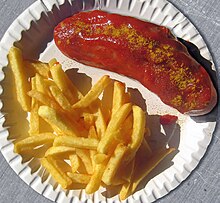
Currywurst and frites, Germany
French fries migrated to the German-speaking countries during the 19th century. In Germany, where they are usually known by the French words pommes frites, or only Pommes or Fritten (derived from the French words but pronounced as German words). They are often served with mayonnaise, and are a popular walking snack offered by Schnellimbiss ("quick bite") kiosks.[42] Since the advent of Currywurst in the 1950s, a paper tray of sausage (bratwurst or bockwurst) anointed with curry ketchup, laced with additional curry powder and a side of french fries, has become an immensely popular fast food meal.[43]
United Kingdom and Ireland
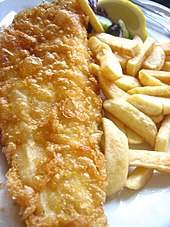
Fish and chips
The standard deep-fried cut potatoes in the United Kingdom are called chips, and are cut into pieces between 10 and 15 mm (0.39 and 0.59 in) wide. They are occasionally made from unpeeled potatoes (skins showing). British chips are not the same thing as potato chips (an American term); those are called "crisps" in Britain. In the UK, chips are part of the popular, and now international, fast food dish fish and chips.
The first chips fried in the UK were sold by Mrs. 'Granny' Duce in one of the West Riding towns in 1854.[44] A blue plaque in Oldham marks the origin of the fish-and-chip shop, and thus the start of the fast food industry in Britain.[45] In Scotland, chips were first sold in Dundee: "in the 1870s, that glory of British gastronomy – the chip – was first sold by Belgian immigrant Edward De Gernier in the city's Greenmarket".[46] In Ireland the first chip shop was "opened by Giuseppe Cervi", an Italian immigrant, "who arrived there in the 1880s".[47] It is estimated that in the UK, 80% of households buy frozen chips each year.[48]
United States
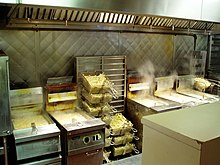
French fry production with thermostatic temperature control, at a restaurant
Although French fries were a popular dish in most British Commonwealth countries, the "thin style" French fries have been popularized worldwide in large part by the large American fast food chains such as McDonald's, Burger King, and Wendy's.[49]
In the United States, the J. R. Simplot Company is credited with successfully commercializing French fries in frozen form during the 1940s. Subsequently, in 1967, Ray Kroc of McDonald's contracted the Simplot company to supply them with frozen fries, replacing fresh-cut potatoes. In 2004, 29% of the United States' potato crop was used to make frozen fries – 90% consumed by the food services sector and 10% by retail.[50] The United States is also known for supplying China with most of their French fries as 70% of China's French fries are imported.[51][41]
Pre-made French fries have been available for home cooking since the 1960s, having been pre-fried (or sometimes baked), frozen and placed in a sealed plastic bag.[52] Some varieties of French fries that appeared later have been battered and breaded, and many fast food chains in the U.S. dust the potatoes with kashi, dextrin, and other flavor coatings for crispier fries with particular tastes.[53] French fries are one of the most popular dishes in the United States, commonly being served as a side dish to entrees and being seen in fast food restaurants. The average American eats around 30 pounds of French fries a year.[54][55]
Variants
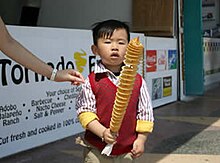
A child holding tornado fries
French fries come in multiple variations. A partial list, in alphabetical order:
Carne asada fries – fries covered with carne asada, guacamole, sour cream and cheese
Cheese fries (UK – cheesy chips) – fries covered with cheese
Chile fries – (not to be confused with chili fries) fries topped with green chile peppers, common in the US state of New Mexico
- Chili fries – (not to be confused with chile fries) fries covered with chili con carne
Chili cheese fries – fries covered with chili and cheese
Chorrillana – a Chilean dish consisting of a plate of french fries topped with different types of sliced meat, sausages and other ingredients.
Crinkle-cut fries – also known as "wavy fries", they're cut in a corrugated, ridged fashion[56]
- Curly fries – characterized by their spring-like shape, cut from whole potatoes using a specialized spiral slicer.[56]
Curry chips – fries covered in curry sauce, a popular item served by chip shops in Ireland
- French fry sandwich[57] – such as the chip butty and the Mitraillette
Oven fries – fries that are cooked in the oven as a final step in the preparation (having been coated with oil during preparation at the factory), often sold frozen
Potato wedges – Thick-cut fries[56] with the skin
Poutine – a dish consisting of fries topped with cheese curds and light brown gravy and principally associated with the Canadian province of Québec- Shoestring fries – thin-cut fries[56]
- Steak fries – thick-cut fries[56] In France, when served with steak, Steak frites
Sweet potato fries – fries made with sweet potatoes instead of traditional white potatoes- Tornado fries – spiral-cut potatoes that are placed on a skewer and then deep fried[56]
Waffle fries – lattice-shaped fries[56] obtained by quarter-turning the potato before each next slide over a grater and deep-frying just once
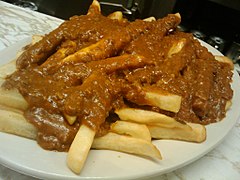
Chili fries

Chili cheese fries

Crinkle-cut fries

Curly fries

Curry chips
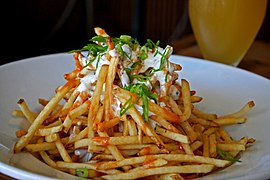
Shoestring fries with blue cheese dressing

Sweet potato fries
Accompaniments
Fries tend to be served with a variety of accompaniments, such as salt and vinegar (malt, balsamic or white), pepper, Cajun seasoning, grated cheese, melted cheese, mushy peas, heated curry sauce, curry ketchup (mildly spiced mix of the former), hot sauce, relish, mustard, mayonnaise, bearnaise sauce, tartar sauce, chili, tzatziki, feta cheese, garlic sauce, fry sauce, butter, sour cream, ranch dressing, barbecue sauce, gravy, honey, aioli, brown sauce, ketchup, lemon juice, piccalilli, pickled cucumber, pickled gherkins, pickled onions or pickled eggs.[58]
Health aspects

Fries frying in oil

Oven-baked fries
French fries primarily contain carbohydrates (mostly in the form of starch) and protein from the potato, and fat absorbed during the deep-frying process. Salt, which contains sodium is almost always applied as a surface seasoning. For example, a large serving of French fries at McDonald's in the United States is 154 grams. The 510 calories come from 66 g of carbohydrates, 24 g of fat, 7 g of protein and 350 mg of sodium.[59]
Experts have criticized French fries for being very unhealthy. According to Jonathan Bonnet, MD, in a TIME magazine article, "fries are nutritionally unrecognizable from a spud" because they "involve frying, salting, and removing one of the healthiest parts of the potato: the skin, where many of the nutrients and fiber are found."[60] Kristin Kirkpatrick, RD, calls French fries "...an extremely starchy vegetable dipped in a fryer that then loads on the unhealthy fat, and what you have left is a food that has no nutritional redeeming value in it at all."[60] David Katz, MD states that "French fries are often the super-fatty side dish to a burger—and both are often used as vehicles for things like sugar-laced ketchup and fatty mayo."[60]
Frying french fries in beef tallow, lard, or other animal fats adds saturated fat to the diet. Replacing animal fats with tropical vegetable oils, such as palm oil, simply substitutes one saturated fat for another. For many years partially hydrogenated vegetable oils were used as a means of avoiding cholesterol and reducing saturated fatty acid content, but in time the trans fat content of these oils was perceived as contributing to cardiovascular disease.[61] Starting in 2008, many restaurant chains and manufacturers of pre-cooked frozen French fries for home reheating phased out trans fat containing vegetable oils.[62][63]
French fries contain some of the highest levels of acrylamides of any foodstuff, and experts have raised concerns about the effects of acrylamides on human health.[64][65] According to the American Cancer Society, it is not clear as of 2013[update] whether acrylamide consumption affects people's risk of getting cancer.[64] A meta-analysis indicated that dietary acrylamide is not related to the risk of most common cancers, but could not exclude a modest association for kidney, endometrial or ovarian cancers.[65] A lower-fat method for producing a French fry-like product is to coat "Frenched" or wedge potatoes in oil and spices/flavoring before baking them. The temperature will be lower compared to deep frying, and which also reduces acrylamide formation.[66]
Legal issues
In June 2004, the United States Department of Agriculture (USDA), with the advisement of a federal district judge from Beaumont, Texas, classified batter-coated French fries as a vegetable under the Perishable Agricultural Commodities Act. This was primarily for trade reasons; French fries do not meet the standard to be listed as a processed food.[67][68] This classification, referred to as the "French fry rule", was upheld in the United States Court of Appeals for the Fifth Circuit case Fleming Companies, Inc. v. USDA.[69][70]
In the United States, in 2002, the McDonald's Corporation agreed to donate to Hindus and other groups to settle lawsuits filed against the chain for mislabeling French fries and hash browns as vegetarian because beef extract was added in their production.[11]
See also
- Avocado fries
Freedom fries- French fry vending machine
- German fries
- List of deep fried foods
- Mitraillette
- Pommes dauphine
- Pommes duchesse
- Pommes soufflées
References
^ "chip: definition of chip in Oxford dictionary (British English)". Oxforddictionaries.com. 12 September 2013. Retrieved 16 September 2013..mw-parser-output cite.citation{font-style:inherit}.mw-parser-output q{quotes:"""""""'""'"}.mw-parser-output code.cs1-code{color:inherit;background:inherit;border:inherit;padding:inherit}.mw-parser-output .cs1-lock-free a{background:url("//upload.wikimedia.org/wikipedia/commons/thumb/6/65/Lock-green.svg/9px-Lock-green.svg.png")no-repeat;background-position:right .1em center}.mw-parser-output .cs1-lock-limited a,.mw-parser-output .cs1-lock-registration a{background:url("//upload.wikimedia.org/wikipedia/commons/thumb/d/d6/Lock-gray-alt-2.svg/9px-Lock-gray-alt-2.svg.png")no-repeat;background-position:right .1em center}.mw-parser-output .cs1-lock-subscription a{background:url("//upload.wikimedia.org/wikipedia/commons/thumb/a/aa/Lock-red-alt-2.svg/9px-Lock-red-alt-2.svg.png")no-repeat;background-position:right .1em center}.mw-parser-output .cs1-subscription,.mw-parser-output .cs1-registration{color:#555}.mw-parser-output .cs1-subscription span,.mw-parser-output .cs1-registration span{border-bottom:1px dotted;cursor:help}.mw-parser-output .cs1-hidden-error{display:none;font-size:100%}.mw-parser-output .cs1-visible-error{font-size:100%}.mw-parser-output .cs1-subscription,.mw-parser-output .cs1-registration,.mw-parser-output .cs1-format{font-size:95%}.mw-parser-output .cs1-kern-left,.mw-parser-output .cs1-kern-wl-left{padding-left:0.2em}.mw-parser-output .cs1-kern-right,.mw-parser-output .cs1-kern-wl-right{padding-right:0.2em}
^ Indian English, "finger chip". Cambridge Dictionary Online.
^ "Chunky oven chips". BBC Good Food. BBC. Retrieved 7 March 2016.
^ abcdef Saint-Ange, Evelyn and Aratow, Paul (translator) (2005) [1927]. La Bonne Cuisine de Madame E. Saint-Ange: The Essential Companion for Authentic French Cooking. Larousse, translation Ten Speed Press. p. 553. ISBN 1-58008-605-5.CS1 maint: Multiple names: authors list (link)
^ Fannie Farmer, The Boston Cooking-School Cook Book, 1896, s.v.
^ Blumenthal, Heston (17 April 2012). "How to cook perfect spuds". the age. Retrieved 12 October 2012.
^ Bocuse, Paul (10 December 1998). La Cuisine du marché (in French). Paris: Flammarion. ISBN 978-2-08-202518-8.
^ abc "Russet Burbank". idahopotato.com. Retrieved 9 January 2018.
^ "The Making of French Fries". thespruce.com. Retrieved 8 December 2017.
^ Schlosser, Eric (2001). Fast Food Nation: The Dark Side of All-American Meal. Houghton Mifflin.
ISBN 0-395-97789-4
^ ab Grace, Francie (5 June 2002). "McDonald's Settles Beef Over Fries". CBS News. Retrieved 4 May 2011.
^ ab Ebeling, Charles (31 October 2005). "French fried: From Monticello to the Moon, A Social, Political and Cultural Appreciation of the French Fry". The Chicago Literary Club. Archived from the original on 3 February 2007. Retrieved 12 January 2007.
^
Fishwick, Marshall W (1998). "The Savant as Gourmet". The Journal of Popular Culture. Oxford: Blackwell Publishing. 32 (part 1): 51–58. doi:10.1111/j.0022-3840.1998.3201_51.x.
^ Home : Oxford English Dictionary. Oed.com. Retrieved 12 September 2012.
^
Mackenzie, Catherine (7 April 1935). "Food the City Likes Best". The New York Times Magazine: SM18. Retrieved 15 April 2007.... the chef at the Rainbow Room launches into a description of his special steak, its French-fried onion rings, its button mushrooms ...
^
Rorer, Sarah Tyson (c. 1902). "Page 211". Mrs. Rorer's New Cook Book. Philadelphia: Arnold & Company. p. 211. Retrieved 12 April 2007.French Fried Chicken
^ ab Schehr, Lawrence R.; Weiss, Allen S. (2001). French Food: On the Table On the Page and in French Culture. Abingdon: Routledge. p. 158. ISBN 0415936284.
^ ab (in French) Hugues Henry (16 August 2001)"La Frite est-elle belge?". Archived from the original on 24 May 2013. Retrieved 3 March 2012. . Frites.be. Retrieved 12 September 2012.
^ ab Ilegems, Paul (1993). De Frietkotcultuur (in Dutch). Loempia. ISBN 90-6771-325-2.
^ Leclercq, Pierre (2 February 2010). La véritable histoire de la pomme de terre frite, musee-gourmandise.be, mentioning the work of Fernand Pirotte on the history of the potato
^ McDonald, George (2007). Frommer's Belgium, Holland & Luxembourg. Wiley Publishing. p. 485. ISBN 978-0-470-06859-5.
^ Jim Chevallier, A History of the Food of Paris: From Roast Mammoth to Steak Frites, 2018,
ISBN 1442272821, pp. 186-187
^ Handy, Mrs. Moses P. "Kitchen Economy in France", Good Housekeeping, Volumes 28–29 159 Vol XXIX No 1 July 1899 Whole No 249. Retrieved 16 November 2014.
^ Schehr, Lawrence R.; Weiss, Allen S. (2001). French Food: On the Table On the Page and in French Culture. Abingdon: Routledge. pp. 158–9. ISBN 0415936284.
^ See this map indicating where patat/friet/frieten is used in the Low Countries
^ (in Dutch) Patatzak vouwen – Video – Allerhande – Albert Heijn. Ah.nl. Retrieved on 13 November 2016.
^ "La Frite se mange-t-elle à toutes les sauces?" (in French). Frites.be. 2011. Archived from the original on 16 November 2008. Retrieved 20 April 2011.
^ "Patatas Bravas". spanish-food.org. Retrieved 12 November 2017.
^ "Galicia Origins". all-about-potatoes.com. Retrieved 12 November 2017.
^ "Saint Teresa". aleteia.org. Retrieved 12 November 2017.
^ "La frite est-elle Belge ou Française ?". Le Monde (in French). 2 January 2013. Retrieved 3 February 2014.
^ Le Moyne Des Essarts, Nicolas-Toussaint (1775). Causes célebres curieuses et interessantes, de toutes les cours ..., Volume 5, p. 41 and P. 159. Retrieved 16 November 2014.
^ Ude, Louis (1822) The French Cook. J. Ebers
^ Warren, Eliza (c. 1859). The economical cookery book for housewives, cooks, and maids-of-all-work, with hints to the mistress and servant. London: Piper, Stephenson, and Spence. p. 88. OCLC 27869877.French fried potatoes
^ N.B. museum celebrates the humble spud | The Chronicle Herald. Thechronicleherald.ca (19 September 2014). Retrieved on 13 November 2016.
^ About McCain Foods – Global Family Owned Food Business. Mccain.com (31 December 1989). Retrieved on 13 November 2016.
^ Semenak, Susan (6 February 2015). "Backstage at La Banquise – because it's always poutine week there". Montreal Gazette.
^ Sekules, Kate (23 May 2007). "A Staple From Quebec, Embarrassing but Adored". The New York Times. Retrieved 19 May 2008. Article on Poutine coming to New York City
^ Kane, Marion (8 November 2008). "The war of the curds". The Star. Retrieved 16 December 2001.
^ "Canada's Imports". frozenfoodsbiz.com. Retrieved 7 January 2018.
^ ab "Potato Imports to China Report". Retrieved 7 January 2018.
^ "Erste Runde – Pommes frites", Atlas zur deutschen Alltagssprache (AdA), Phil.-Hist. Fakultät, Universität Augsburg, 10. November 2005
^ Currywurst – die Erfindung: Nur ohne ist sie das Original Archived 28 April 2015 at the Wayback Machine.
^ Chaloner, W. H.; Henderson, W. O. (1990). Industry and Innovation: Selected Essays. Taylor & Francis
ISBN 0714633356.
^ The Portuguese gave us fried fish, the Belgians invented chips but 150 years ago an East End boy united them to create The World's Greatest Double Act Daily Mail. Retrieved 21 September 2011
^ "Dundee Fact File". Dundee City Council. Archived from the original on 8 April 2007. Retrieved 20 March 2007.
^ "A postcard, Giuseppe Cervi and the story of the Dublin chipper". Come Here To Me!. 14 March 2017. Retrieved 15 March 2017.
^ "Top Chip Facts". Archived from the original on 11 February 2011. Retrieved 11 February 2011.CS1 maint: BOT: original-url status unknown (link) . Lovechips.co.uk. 27 February 2011
^ "Popularization". today.com. Retrieved 3 January 2018.
^ "Frozen Potato Fries Situation and Outlook". Archived from the original on 15 December 2013. Retrieved 12 September 2012.
^ "China's US importation". forbes.com. Retrieved 7 January 2018.
^ "Pre-Made Fries". historyoffastfood.com. Retrieved 3 January 2018.
^ "Flavor Coatings". EcolefoodPolitics.wordpress.com. Retrieved 3 January 2018.
^ "Amount of French Fries". foxnews.com. Retrieved 4 January 2018.
^ "French Fries Amount". fooddemocracy.wordpress.com. Retrieved 4 January 2018.
^ abcdefg Lingle, B. (2016). Fries!: An Illustrated Guide to the World's Favorite Food. Chronicle Books. pp. 50–53. ISBN 978-1-61689-504-4. Retrieved 1 July 2017.
^ The U.S. Open is selling a delicious sandwich with french fries on it | For The Win. Ftw.usatoday.com (17 June 2016). Retrieved on 13 November 2016.
^ List of accompaniments to french fries – Unlikely Words – A blog of Boston, Providence, and the world. Unlikely Words (7 November 2011). Retrieved 12 September 2012.
^ "McDonald's Nutrition Facts for Popular Menu Items" (PDF). nutrition.mcdonalds.com.
^ abc Fried Potatoes and Acrylamide: Are French Fries Bad For You?. Time.com (11 June 2015). Retrieved on 13 November 2016.
^ "Health Risks". forbes.com. Retrieved 4 January 2018.
^ "McDonalds Trans fats". reuters.com. Retrieved 4 January 2018.
^ "Burger King Trans fats". Nbcnews.com. Retrieved 4 January 2018.
^ ab "Acrylamide". American Cancer Society. 1 October 2013.
^ ab Pelucchi C, Bosetti C, Galeone C, La Vecchia C (2015). "Dietary acrylamide and cancer risk: an updated meta-analysis". Int. J. Cancer. 136 (12): 2912–22. doi:10.1002/ijc.29339. PMID 25403648.
^ "Eat Fries—Guilt-Free!". Prevention. Retrieved 19 April 2016.
^ "Country of Origin Labelling: Frequently Asked Questions". Agricultural Marketing Service. 12 January 2009.
^ Dreyfuss, Ira (16 June 2004). "Batter-Coated Frozen French Fries Called Fresh Vegetable". The Washington Post.
^ "AGRICULTURAL MARKETING AGREEMENT ACT - vol63_at_958.pdf" (PDF). Archived from the original (PDF) on 15 December 2013. Retrieved 16 September 2013.
^ "04-40802: Fleming Companies v. Dept of Agriculture :: Fifth Circuit :: US Court of Appeals Cases :: Justia". Law.justia.com. Retrieved 16 September 2013.
Bibliography
| Wikimedia Commons has media related to French fries. |
Wikibooks Cookbook has a recipe/module on
|
| Look up french fries in Wiktionary, the free dictionary. |
Lingle, Blake (2016). Fries! : An Illustrated Guide to the World's Favorite Food. New York: Princeton Architectural Press. ISBN 9781616894580.
Tebben, Maryann (2006). "French Fries: France's Culinary Identity from Brillat-Savarin to Barthes (essay)". Convivium Artium. University of Texas at San Antonio. Retrieved 28 December 2009.








